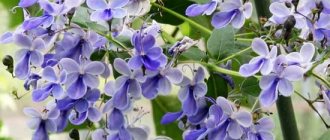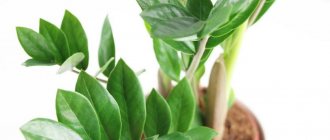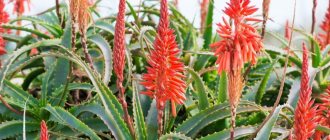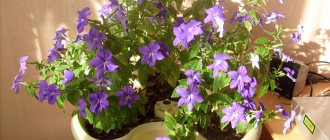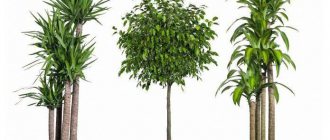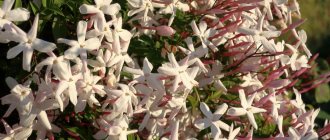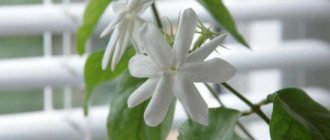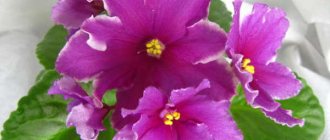OgorodGuruCom
Tips and tricks for gardeners
Popular
How to permanently remove horse sorrel from the site
Home › Herbs and Spices › Is it possible to grow ginger in Russia and what is needed for this
Ginger is a perennial herb that is widely used in cooking, medicine and cosmetology. Gardeners make every effort to grow this subtropical plant, but the results are not always positive.
Description of the plant
Ginger flower can be decorative and medicinal, which is also used in cooking. The plant comes from places where the tropical climate prevails. Therefore, for comfort it is necessary to provide high humidity and warmth.
Ginger during flowering
Appearance
When discussing ginger, what it is, the first thing that comes to mind is its root, which is similar to Jerusalem artichoke. This is a tuberous plant, often called earthen pear. Many people don’t even think about what the ginger plant looks like.
Decorative species have more colorful flowering. Ginger, used in medicine and cooking, does not bloom so profusely as to direct energy to the formation of a powerful rhizome. Due to its external similarity, the plant is compared to reeds. But its stem is not covered with scales.
Bloom
Ginger blooms in spring and summer, and at home this is an extremely rare occurrence. With proper care and comfortable conditions, flowers appear in the third year of life. The color depends on the type of exotic representative of the flora. The most common shades:
- brown;
- orange-yellow;
- red.
What does a ginger plant look like:
- The inflorescences resemble ears of corn formed at the top of the stem from leaves rolled into a tube. They can be plain or combine several shades;
- The shape of the inflorescences is varied. They look like cones, lilies, peonies.
Note! The flowering period is accompanied by the spread of a sweet aroma. It can lead to allergic reactions. With the onset of cold weather, flowering ends.
Leaves
Leaves begin to grow at the root. They are narrow and reach a length of 20 centimeters, while the plant itself can grow up to two meters. The leaves are pointed at the ends and have scales.
Root
The root of the plant is located almost on the surface, in the top layer of soil. An underground stem covered with leaves is often confused with it. It is yellow and fleshy inside. The rhizome develops and produces above-ground stems. Leaves and inflorescences subsequently form on them.
Root
The root has a pungent taste; in English it sounds like ginger. The word has a different meaning - piquancy, which fully reflects the quality of the plant.
How to choose and where to buy ginger root
Ginger root can be found in the produce section of most supermarkets. The fresher the rhizome, the more flavor it has.
Look for ginger with clean, unblemished skin, not raw or moldy, and heavy in weight. Buy it in small quantities, as only a few centimeters are needed for cooking. Avoid soft and wrinkled roots.
Organic quality ground ginger (dry powder) can be purchased from this online store:
Varieties and types for cultivation
How to care for an avocado plant at home
Typically, ginger root is light, slightly yellowish. Over time, during long-term storage, it darkens and turns brown. It is white when cut and then turns yellow. There is a variety that is distinguished by a reddish color on the cut. But this is its only feature; it does not affect the taste and appearance of the above-ground part of the plant.
Different varieties differ in the color of the inflorescences. They can be:
- green;
- purple;
- yellow with blue veins.
Flowers smell differently:
- orange;
- fresh cut grass;
- kerosene.
The shape and length of the rhizome are another distinguishing feature. There are different underground stems:
- resembling a fist or hand with fingers spread;
- round and flattened;
- elongated;
- horned.
Ginger Zerumbet
Zerumbet ginger is an ornamental plant whose inflorescences resemble a cone. Its scales are tightly closed. At first they are green, during flowering they turn bright red, then acquire a brown tint. At this time, between the scales you can find seeds that are used for reproduction.
The plant is popular because it is considered unpretentious. It can be grown at home and in open ground.
Ginger Zerumbet
Additional Information. Zerumbet has beneficial properties: the inflorescences contain liquid that can be added to shampoo and washed your hair.
Ginger purple
Purple ginger is also called Plai. It differs from the usual one in that it has a cooling effect. Therefore, it is often used in medicine as an analgesic and antiseptic.
The root part is yellow or green. It grows mainly in India and Thailand. In spring and summer, flowers appear; they can be white or yellow. At the same time, a pleasant aroma with a camphor note spreads. Purple ginger is often added to essential oil and provides benefits for:
- joint pain;
- asthma attacks;
- intestinal problems;
- fatigue, insomnia.
White ginger
White ginger is also called Bengal ginger. This is a plant variety intended for trade. The root is taken out of the ground and cleaned. Then it is kept for some time in a weak solution of sulfuric acid. The purpose of the procedure is to make the root not so spicy, it becomes soft and has a pleasant aroma.
Black ginger
Black ginger is also a commercial variety of the plant. Its other name is “Barbadosian”. After the roots are taken out of the ground, they are watered with boiling water. Thanks to this action, the root acquires a burning and pungent taste.
Pink ginger
Pickled ginger (gari) is red in color. When cut from a fresh root, the color is yellowish-gray. It turns red as a result of the action of vinegar and sugar with which the plant is mixed. It is usually served with fish dishes to overcome the taste and move on to the next product.
Restaurants specializing in Japanese cuisine always use pickled root when serving their dishes. Many delivery services use the plant in their name, for example, “Ginger” in Zlatoust, “Southern Ginger” in Krasnaya Polyana.
Ginger Myoga
Myoga is a Japanese ginger that is frost-resistant. This is the only plant from the Ginger family that can survive in temperatures below zero. Residents of Japan value the buds that are used for food:
- stewed, pickled, preserved;
- added to soups;
- used as a seasoning.
Ginger Myoga
Medicinal ginger
Ginger is a plant known for its medicinal properties. The inflorescence of a pharmaceutical tropical representative of the flora resembles a cone and is called spicate. It is not found in the wild. The flowers are violet-brown or yellow. In medicine, the roots of the plant are used, which are dug up after flowering. Then cleaned and dried. Their color is white-yellow, they have a pungent aroma and a pungent taste.
Chemical composition
The chemical composition of the root includes about 400 useful substances and components. Here is a far from complete list of them:
Magnesium.- Phosphorus.
- Calcium.
- Sodium.
- Iron.
- Zinc.
- Potassium.
- B vitamins.
- Vitamin A, E, K.
- Ascorbic acid.
- nicotinic acid and a number of other essential amino acids.
- Omega-3 and Omega-6 fatty acids.
- Active biochemical compounds:
- quercetin;
- ferulic acid;
- borneol;
- myrcene;
- gingerol;
- shogaol;
- retinol;
- thiamine;
- riboflavin.
Medicinal properties
The positive effects of ginger on the body are explained by its composition; it is even called the golden healer. It contains essential oils, vitamins, amino acids, and substances that have an antiseptic and analgesic effect.
What does ginger treat:
- has a laxative and choleretic effect;
- helps fight worms;
- used in hot weather as a diaphoretic;
- stimulates blood circulation;
- treats muscle, joint pain and inflammation.
Also used for nervous disorders that are accompanied by aggression. In addition, it helps restore memory and improves attention.
Important! When using medicines based on the root of the plant, even if it is an essential oil, you should consult your doctor. There are contraindications for use. Not recommended for use during pregnancy and lactation, as well as in children under 7 years of age.
Benefits for weight loss
In animal studies, ginger consumption showed significant reductions in blood sugar and insulin levels (up to 35%). Theoretically, this could indicate the benefits of ginger root for weight loss. However, studies in humans have not shown the same result - the effect on the level of insulin produced by the body was minimal¹. Despite this, ginger is able to reduce appetite and increase the thermic effect of food (although, again, extremely slightly). In fact, hot ginger tea can be useful when following a diet to combat hunger - but ginger itself cannot be said to help you lose weight or speed up the burning of fat deposits.
Use in cooking
The burning plant is widely used in cooking. Adding root vegetables to dishes will help reveal the taste of the remaining ingredients, the main thing is to use the product correctly. It can be consumed fresh, dried, or pickled. It is added either entirely or in parts. The powder is used to prepare soups, sauces, and desserts.
Note! Chopped fresh ginger is best added to meat and fish dishes. And do this 15 minutes before the dish is ready.
The root vegetable is used to make dough and is added during kneading. To prepare the sauce, add the ginger at the very end. Many desserts and drinks are incomplete without hot spices.
Drinks are popular due to not only their original taste and tonic effect, but they also promote weight loss. To make tea with ginger, you need to grate a teaspoon of the root and brew it with boiling water. Ginger goes well with honey. The main thing is to remember that it is added at the end, when the drink has cooled to room temperature. Otherwise, honey will release carcinogens that are dangerous to the body. Add a slice of lemon to the finished drink.
Ginger tea
Lemonade and kvass are prepared from the fresh root. You can make a delicious dessert with the addition of dried fruits. They need to be boiled, adding any spices to taste, for example, cardamom, cinnamon, cloves.
Which dried fruits to choose depends on preferences:
- apples;
- raisin;
- dried apricots;
- prunes;
- dates.
When the mixture diluted with water thickens, add a teaspoon of ginger. The syrup goes well with ice cream.
Turmeric and ginger
Often when preparing dishes, the question arises whether ginger and turmeric are the same thing, and whether they are interchangeable spices. The plants belong to the same family, so they can be considered relatives. They have some similarities regarding appearance and development. Turmeric also uses the root. But its taste is not so hot, it is softer and more pleasant. Therefore, when adding to foods during cooking, you don’t have to worry about ruining the dish. Another similarity is the warming effect that both plants have.
Turmeric contains coloring pigments, even the root is bright yellow when cut. Therefore, it is often used in cooking to give the desired shade. Turmeric is also valued in light industry and folk medicine. Mainly, it fights bacterial and viral infections and is able to heal wounds.
Main differences:
- taste;
- root color on cut.
Contraindications
Since ginger can slow down blood clotting, it should not be used in conjunction with anticoagulants and similar drugs. It is also not recommended to combine it with aspirin, ibuprofen, diclofelac and a number of other painkillers³. Ginger is contraindicated if you are taking medications to treat diabetes or high blood pressure. In addition, ginger increases the risk of internal bleeding - it should not be used for gastritis, stomach ulcers and hemorrhoids. Note that safety for pregnant and lactating women is also relative - although ginger is used to reduce morning sickness, in one of the documented cases its use provoked a miscarriage.
Growing ginger at home
You can grow ginger from store-bought root. The main thing is that it is fresh and elastic. Buds are noticeable on the root, which will help a new plant emerge. In order for them to wake up, you need to put the planting material in water for a couple of hours.
Note! If part of the root is taken and a cut is made, then the wound must be treated. Coal and a weak solution of potassium permanganate are suitable for this.
Place drainage in the pot, then prepared soil. It should consist of:
- sand;
- turf;
- humus.
The root is deepened 3 centimeters so that the buds are at the top. It is necessary to water the plant abundantly; shoots will appear in 2-3 weeks.
Growing at home
It is important to provide the flower with comfortable conditions:
- to create high humidity, spray periodically;
- protect from direct rays of the sun;
- water depending on the temperature, in hot weather increase the frequency of moistening, avoid drying out the soil;
- after the leaves wither, remove them and dig up the root, peel, dry, and, if necessary, store at a temperature of about 4 degrees.
Care depends on what the ginger is needed for. If purchased for flowering, as an ornamental plant, then at home you need to follow simple rules:
- do not remove the rhizome after the leaves wither;
- In winter, water rarely, ensuring the plant rest;
- in the spring, feed and increase watering;
- use a small pot to limit root growth.
Ginger is a plant that has both decorative properties and is widely used in medicine and cooking. The flower comes from a tropical climate and can be kept at home, providing warmth and creating high humidity.
Care
Maintaining warm temperatures and regular watering will help you succeed in growing ginger as a houseplant.
If your goal is to obtain a useful root , then in the fall, when the leaves begin to turn yellow and wither, stop watering and cut off the stems of the plant:
- Remove the rhizome from the ground and clean it from the soil.
- White young shoots can be stored in the refrigerator or a dry, ventilated area to be replanted in the soil in January to grow a new crop.
- The rhizome for which you have been growing ginger for 9 months can be used as a medicine, fresh or frozen.
Well-dried and crushed root is suitable as a flavoring additive . Place the harvest, cutting it into slices, in a dry, well-ventilated area for two to three months, and then chop thoroughly.
